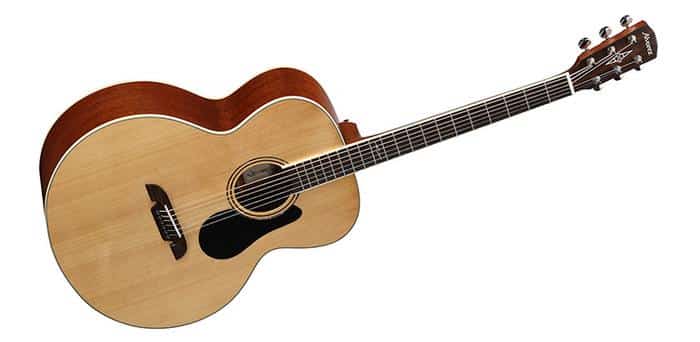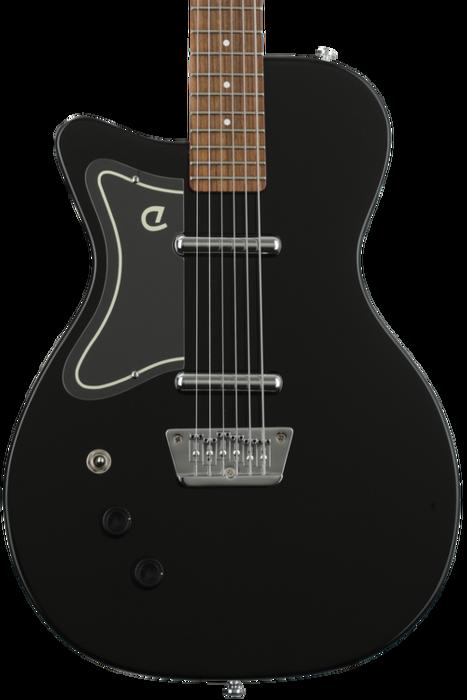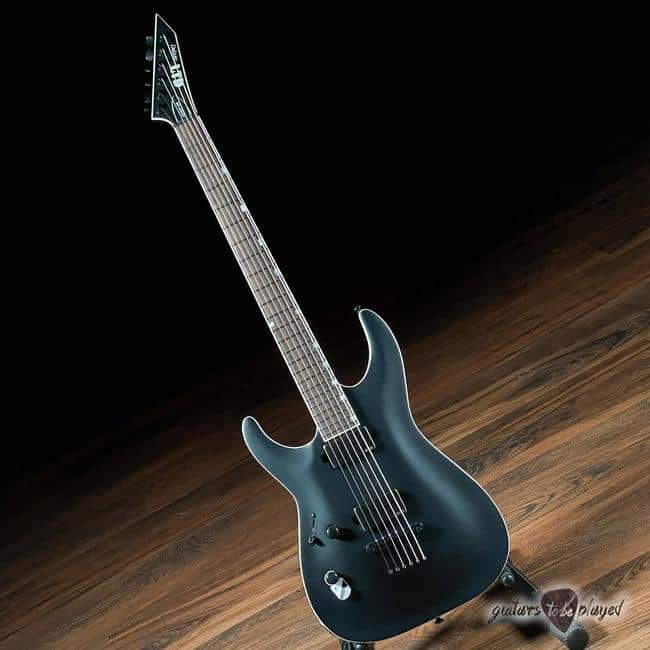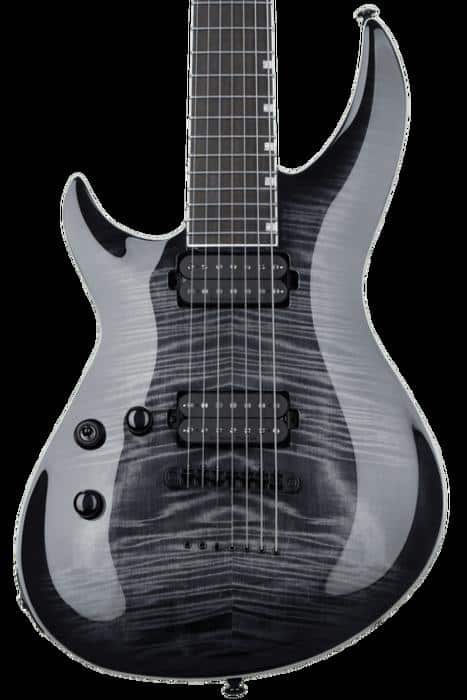Think again if you believe that the baritone guitar is an instrument exclusively for right-handers. As a seasoned left-handed musician and confessed baritone-enthraliast, my left-handed baritone guitar has been a major game-changer in my musical trajectory.
Embracing the deep, dulcet tones of my left-handed baritone guitar strengthened my musical prowess in a fascinating way. I started embarking on musical journeys previously unimagined, exploring textures of unfamiliar chords and depths of untapped creativity. However, let’s withhold the resolution for a bit.
My passion for such an uncommon instrument has led me to create this comprehensive guide. It’s dedicated to all the lefties out there who, like myself, wish to delve into the rich and harmonious world of baritone guitars.
Unveiling the peculiarities of left-handed baritone guitars and sharing personal recommendations, this guide will be a compass for southpaw musicians aspiring to wield the power of this soulful instrument. So, fasten your seatbelts, and let’s embark on this musical adventure together.
Understanding Baritone Guitars
What is a Baritone Guitar?

Within the intriguing world of extended range guitars, the baritone guitar stands as a captivating outlier. Possessing a scale length that comfortably stretches between 27 and 30.5 inches, a baritone guitar is essentially designed to be tuned a perfect fourth to fifth interval lower than a standard guitar, typically between A to C. The result? Rich, resonant lows and an expanded tonal spectrum.
My fascination for baritone guitars lies in their unique tuning. Baritone guitar tuning, with its deeply resonating timbre and expansive tonal range, offers an audacious soundscape capable of enriching any musical composition. Whether you desire to provide depth to a rock ensemble or craft a solo piece with depth and drama, the baritone guitar delivers an aural experience that is simply inimitable.
One cannot truly grasp the audacious charm of this instrument without mentioning the invigorating experience of mastering its unusual extended scale. The wider fret spacing demands an adaptation of technique essential for harnessing the guitar’s full potential. As you become one with this instrument, the baritone guitar rewards your perseverance and experiment, infusing your music with a brilliant depth, an intriguing warmth, and a thrilling range that continually inspires.
And so, the baritone guitar’s contribution to the musical lexicon is noteworthy. It serves as a shining example of the boundless creativity fostered by the attempt to desist from the norm and explore new musical pastures. As we further progress into exploring the intricacies of the left-handed baritone guitar, allow me to guide you in discovering the profound richness it can lend to your musical journey.
Why Choose a Left-Handed Model?

Having personally faced the challenges and delights of mastering a left-handed guitar, I can vouch for the multitude of hidden benefits associated with left-hand musical instruments. Providing for immersive, tailor-made musical engagement, left-handed guitar models often remain an overlooked yet rewarding alternative for southpaws venturing into the world of baritone guitars.
Investing in a left-hand baritone model translates into a more comfortable, intuitive learning curve, fostering enhanced performance and progression. The configuration naturally aligns with the left-hander’s dexterity, enabling efficient fretting and strumming. This alignment with one’s dominant hand can serve to deepen the connection between the player and the instrument, eliciting an enriched musical experience.
Interlacing traditional music frameworks with an innovative reverse pull, left-hand models imbue a distinctive tonal character and creative potential. A southpaw wielding a guitar that’s truly ‘handed’ to their needs can elicit novel instrumental expressions and chord structures, contributing a quirky edge to the otherwise monotonous right-handed realm. Furthermore, iconic players like Jimi Hendrix and Paul McCartney, renowned for their left-handed prowess, echo the potential that a left-handed perspective can bring to music.
In the realm of baritones, left-handed designs may currently be limited, yet they resonate profound benefits. Rather than adapting to the conventions of right-handed designs, left-handers should embrace their individuality and seek out left-hand guitar models that allow for an ismorphic musical journey. In doing so, they not only uphold their convenience but also fuel their artistic distinctiveness. Stay tuned as we endeavour to navigate some popular choices of left-handed baritone models in the subsequent discussions.
Popular Left-Handed Baritone Guitar Models
Danelectro Baritone for Left-Handers

Transitioning from the broader perspective of popular left-handed baritone models, let’s take a closer look at a particular favourite of mine: the Danelectro Baritone for left-handers. What makes this model a standout in my collection is its distinctive blend of comfortable playability, rich tone, and affordability, which make it an excellent choice for both beginners and seasoned ‘southpaws’ alike.
Danelectro’s unique construction, with its iconic semi-hollow body, lends this baritone model a naturally full, resonant sound. Simultaneously, its extended scale length ensures the chords and single notes ring out with clarity and richness. This guitar brings out the depth and warmth that baritone players adore, while its dual-lipstick pickups provide a wide range of tonal possibilities – from jangly cleans to surfy twang.
I’ve played countless shows and studio sessions with this guitar, and the Danelectro’s unwavering reliability and versatile tone always shine through. As a lefty, it’s even more significant, providing a rare sense of ‘fittingness’ that such models designed specifically for us offer. For those exploring the realm of left-handed baritone guitars, Danelectro Baritone for left-handers is indeed a worthy addition to your arsenal.
Rivolta Mondata Baritone VII LH

Delving deeper into the world of left-handed baritone guitars, let us explore the edge and character of the Rivolta Mondata Baritone VII LH. As a left-handed guitarist myself, I’ve found this model truly enriches my repertoire with its exceptional sound dynamics, a noteworthy contributor to our category ‘Popular Left-Handed Baritone Guitar Models’.
Rivolta has masterfully designed the Mondata Baritone VII LH to create the foundation of an otherworldly and profound musical experience. The distinctive sound of this model allows my musical ideas to truly come alive, offering a rare blend of warmth and clarity. Its tonal richness, coupled with the hassle-free playability, make it a reliable companion for left-handed musicians like us, who are often challenged by limited options.
Indeed, the Rivolta Mondata Baritone VII LH amplifies our musical expression profoundly. Each strum brings forth a unique resonance that’s truly captivating. An essential pick for any left-handed musician, this model’s contribution to the baritone guitar community is considerable. The journey continues and where it brings us, only our music can tell. Let’s embrace the unknown with open arms, and the expertise I’ve gained in this niche will guide us on this adventure.
Agile Lefty Baritone

As a southpaw guitarist, I’ve personally had a rewarding experience using the Agile Lefty Baritone. This model stands out remarkably within the category of Popular Left-Handed Baritone Guitar Models. Agile has thoughtfully crafted this lefty baritone keeping in mind the specific posture requirements and comfort of left-handed players.
The Agile lefty baritone is an embodiment of design perfection, acoustic richness, and comfortable playability. Its attractive design complements the rich, deep baritone sounds it produces. This synthesis of aesthetics and sound quality provides an unparalleled musical experience for left-handed musicians.
Not only have I found comfort while playing this guitar, but its detailed craftsmanship and supreme sound quality have also enhanced my performances. Whether you’re a professional musician or a hobbyist, the Agile lefty baritone is a worthwhile addition to your collection.
As we navigate further into the realm of specialized left-handed baritone guitars, my personal experience is a testament to the Agile Lefty’s substantial value and contribution to this unique niche. Considering our foray into custom options next, the Agile model’s design and player comfort set a high benchmark.
Custom Left-Handed Baritone Guitars

In the realm of left-handed baritone guitars, there’s something uniquely satisfying about owning a custom-made model. Having spent years immersed in lutherie, I can attest to the joy sparked by a custom left-handed baritone. These pieces aren’t simply instruments, but personalized creations tailored for specific needs and preferences.
What makes custom left-handed baritones so special? The flexibility to adapt to each player’s precise requirements. The process tends to involve detailed consultation and collaborative design, resulting in optimal playability and aesthetics for the southpaw guitarist. Such guitars are naturally equipped to handle the lower pitch of the instrument, and the left-handed specificity means the design and structure cater to left-handed playing techniques, enhancing comfort and versatility. This is without even touching upon the scope for striking aesthetic choices!
Delving into the realm of custom left-handed baritone guitars is a journey of self-discovery as much as it is about the music. It allows a level of self-expression that pre-made guitars simply can’t offer. They aren’t just tools, but reflections of ourselves, our ideas, and our unrivaled love for the deep, resonant tones of baritone guitars.
Tips for Left-Handed Baritone Guitar Shopping

After an enlightening introduction to baritone guitars and a respectful nod to the popular left-handed models in the industry, it’s now time to dabble into the real essence of this guide: left-handed guitar shopping. Just thinking about it sends a thrill down my spine. There’s something uniquely invigorating about the prospect of a new instrument, especially when you’re a left-handed player like myself searching for that perfect baritone guitar.
Intriguing question: How does one navigate the world of left-handed guitars without getting lost in the many options available? Let’s explore together. With my years of experience in both playing and crafting guitars, I’ve collected a set of tips that I believe will aid you in navigating the market for a left-handed baritone guitar.
Understanding Your Requirements is crucial; you need to determine the tonal range, type of music you play, and your budget. These factors can greatly influence your choice. For example, if you’re into jazz, a semi-acoustic might be more suitable.
Appreciating the importance of trying before buying can’t be stressed enough. As left-handed players, we’ve always had to make do with limited options. So, when you spot a left-handed baritone, it’s essential to pick it up and play. You need to feel the neck, the body, and the sound. It should resonate, not just with your ears, but also with your soul. Believe me, when it’s a perfect fit, you’ll know.
Patience, my friends, is truly a virtue when it comes to left-handed guitar shopping. Sometimes, it takes time to find that perfect fit, that instrument which feels like an extension of your own body. Don’t rush the process. From my own experiences, I can tell you that waiting for the right guitar is absolutely worth the time.
Research is another weapon to wield when shopping. Learn about your favorite brands, their reputations, and their customer service reviews. For instance, some manufacturers, like Danelectro, are noted for their unique left-handed baritone guitars, while others may offer better customization facilities.
Understanding that customization can make a huge difference is key. Many left-handed players opt for customizing their guitars simply because of the limited choices out there. If you’re unable to find what you’re looking for, you can always think of this as a viable option. It might cost a bit more, but at the end of the day, the instrument will be a perfect reflection of you.
Before we part, remember these tips aren’t a definitive guide but mere suggestions. The ultimate choice should always rest with you. No matter what, choose an instrument that brings you joy. In the end, it’s all about the music and how you choose to express it.
So, ready to groove to the cadence of strings strummed by your left hand? Let’s continue our journey into the fascinating world of baritone guitars for southpaws in the FAQs section next.
FAQs
What is a left-handed baritone guitar?
Why is a left-handed baritone guitar significant to southpaws?
Are left-handed baritone guitars harder to play?
Where can I purchase a left-handed baritone guitar?
Conclusion
Bold Statement: Left-handed or not, when it comes to guitars, there’s something for everyone. Let’s decode the mysterious world of left-handed baritone guitars. Over the course of this in-depth guide, we’ve walked the beautiful path together, exploring the nuances and benefits of playing a left handed baritone guitar. The rich, punchy and warm sound of the baritone guitat, coupled with the unique experience of playing it in a left-handed manner, provides a musical journey unmatched.
From the comparison of popular left-handed baritone guitar models, like the Danelectro Baritone for Left-Handers and the Rivolta Mondata Baritone VII LH, to custom guitars, we’ve covered a wide range of options to cater to every southpaw’s needs. We’ve even delved into the helpful tips to guide you in your guitar shopping endeavors, ensuring that you find the perfect fit for your musical desires.
In conclusion, much like my many years of experience as a luthier and musician has shown me, I hope this guide perks up your interest and fuels your passion for left handed baritone guitar playing. The complexity and harmony this instrument provides is bound to create a transformative experience for every musician, a unique musical tale waiting to be told.